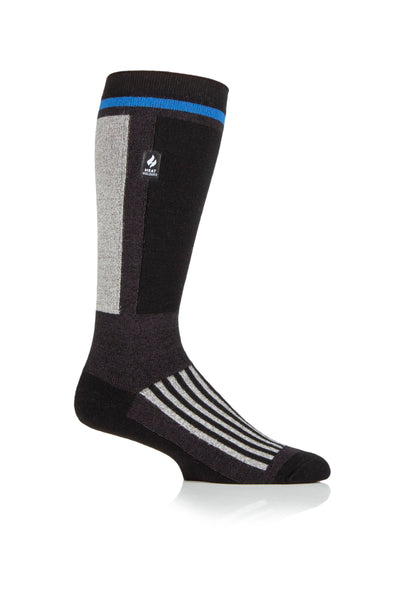When it comes to skiing, having the right gear is crucial for performance and enjoyment. One often overlooked but essential element is the choice of socks. This article will guide you through the importance of proper ski socks, the different types available, key features to consider, common mistakes to avoid, and how to care for your ski socks to ensure their longevity.
Understanding the Importance of Proper Ski Socks
Ski socks are more than just a warm layer for your feet; they play a significant role in your overall skiing experience. A good pair of ski socks can enhance your performance on the slopes, keep your feet comfortable, and even protect them from injuries.
Wearing the right socks can prevent issues such as blisters and cold feet, which can drastically affect your ability to enjoy your time skiing. Moreover, ski socks are specifically designed to provide support and cushioning, which is crucial when navigating challenging terrains.
The Role of Ski Socks in Performance
The fit and construction of ski socks directly influence how your ski boots fit. Well-fitted ski socks can ensure your feet are snug against the liner of the boot, maximizing control and sensitivity when making turns. This increased responsiveness translates into better performance on the slopes.
Additionally, ski socks are often crafted with specific pad placements to provide optimization for pressure points that are common for skiers, enhancing both comfort and efficiency during use. Understanding this aspect will help you make informed choices about sock selection. The materials used in ski socks also play a crucial role; many are made from moisture-wicking fabrics that help keep your feet dry by pulling sweat away from the skin. This not only helps to maintain warmth but also reduces the risk of blisters, allowing you to focus on your technique rather than your discomfort.
Health and Comfort Considerations
Choosing the right ski socks is not just about performance; it’s also about health and comfort. Poorly fitted or inappropriate socks can lead to various foot ailments. Blisters, calluses, and even frostbite are possibilities for those who venture out with inadequate sock choices.
Comfort also plays a role in your enjoyment of the skiing experience. Discomfort in your feet can turn an exhilarating day on the slopes into an agonizing one. By selecting high-quality, comfortable ski socks, you can significantly improve your skiing experience. Furthermore, many ski socks come with additional features such as arch support and cushioning in the heel and toe areas, which can help reduce fatigue during long days on the mountain.
These thoughtful designs ensure that your feet remain supported, allowing you to tackle challenging runs with confidence and ease. Additionally, some brands even offer socks with graduated compression, which can enhance blood circulation and reduce swelling, further contributing to your overall comfort and performance on the slopes.
Different Types of Ski Socks
Understanding the different types of ski socks available will help you choose the best pair for your skiing style, feet size, and personal preferences. Generally, ski socks can be categorized based on material, thickness, and intended use.
Material Differences: Wool vs. Synthetic
One of the primary considerations when selecting ski socks is the material. The two most common types are wool and synthetic fibers, each offering distinct benefits.
-
Wool: Merino wool is popular due to its thermal properties, moisture-wicking capabilities, and natural breathability. It keeps your feet warm even when wet and tends to be more comfortable in varying weather conditions.
-
Synthetic: Synthetic fibers, often made from polyester or nylon, tend to be more durable and quick-drying than wool. They can provide good moisture control and are typically lighter. However, while modern synthetics have improved in warmth, they may not always match the insulating properties of wool.
Sock Thickness and Its Impact on Skiing
Sock thickness is another critical factor to consider. Ski socks come in various thicknesses, ranging from ultra-thin to heavy. The choice of thickness directly impacts how your ski boots fit and how well they perform.
Many skiers prefer mid-weight socks as they strike a balance between warmth and fit. Thick socks may provide additional warmth but can lead to a snug boot fit, which may compromise blood flow and lead to cold feet. On the other hand, thin socks allow for better control and sensitivity but may not provide enough insulation in extremely cold conditions.
Additionally, the thickness of the sock can influence the overall comfort during long days on the slopes. For instance, a thicker sock may offer extra cushioning, which can be beneficial for skiers who spend hours navigating challenging terrain. However, it’s essential to ensure that the sock doesn’t bunch up inside the boot, as this can create pressure points and discomfort. Many brands now offer anatomical designs that contour to the foot’s shape, providing a more customized fit regardless of thickness.
Another aspect to consider is the sock's cushioning zones. Some ski socks feature targeted cushioning in high-impact areas, such as the shin and heel, which can enhance comfort and reduce fatigue. This specialized padding can be particularly advantageous for those who engage in aggressive skiing or spend extended periods on the mountain. Ultimately, the right combination of material, thickness, and cushioning will not only improve your performance but also enhance your overall skiing experience.
Key Features to Look for in Ski Socks
When shopping for ski socks, there are several key features to consider that can enhance their functionality and your overall comfort while skiing.
Padding and Support
Many ski socks come with strategically placed padding to provide cushioning to areas that experience pressure from ski boots. This can include the shin, heel, and footbed, ensuring you can ski for longer periods without discomfort.
Support through arch and ankle compression can also help to improve blood circulation and reduce fatigue. This additional support is particularly important for skiers who spend long hours on the slopes. Additionally, some ski socks are designed with graduated compression technology, which not only enhances blood flow but also helps to minimize muscle vibration, potentially reducing the risk of injury during intense skiing sessions.
Breathability and Moisture Management
Breathability is essential for keeping your feet dry and comfortable. Quality ski socks will feature moisture-wicking properties, transferring moisture away from your skin to the outer layers of the sock where it can evaporate.
Good ski socks also utilize mesh zones or perforations to enhance ventilation, preventing the build-up of sweat that can lead to chilly feet or even frostbite. Make sure your ski socks have these features to ensure you remain comfortable, no matter the conditions.
Furthermore, many modern ski socks incorporate advanced materials such as Merino wool or synthetic blends that not only wick moisture effectively but also provide natural temperature regulation, keeping your feet warm in cold weather and cool when the temperatures rise. This adaptability is crucial for skiers who may encounter varying conditions throughout the day, from sunny slopes to shaded trails.
Common Mistakes When Choosing Ski Socks
Even the most experienced skiers can make mistakes when it comes to selecting the appropriate socks. Being aware of these common pitfalls will help you make better choices.
Avoiding Ill-Fitting Socks
Ill-fitting socks can ruin your skiing experience. Socks that are too tight can restrict circulation and cause discomfort, while socks that are too loose may bunch up inside your boots, leading to blisters and hot spots. Always choose socks that fit snugly without being overly tight.
Consider your footwear size as well when selecting ski socks. Different brands may have different sizing, so always check the manufacturer's recommendations before your purchase. Additionally, pay attention to the sock's material composition; materials like Merino wool or synthetic blends can offer better moisture-wicking properties and temperature regulation, which are crucial for maintaining comfort on the slopes. A good fit combined with the right fabric can make all the difference in your skiing experience.
The Myth of Doubling Up Socks
Many skiers mistakenly believe that wearing two pairs of socks will keep their feet warmer. However, this approach can backfire, leading to decreased circulation and increased chances of blisters. Instead, opt for high-quality, warm ski socks designed specifically for the activity to keep your feet cozy without the added bulk.
It's also essential to consider the thickness of the socks you choose. Thicker socks might seem like a good idea for insulation, but they can compromise the fit of your ski boots, leading to discomfort and reduced control. Look for socks that offer a balance between warmth and thinness, ensuring you maintain a snug fit in your boots while still enjoying the insulation you need. Furthermore, many modern ski socks come with additional features such as arch support and cushioning in key areas, which can enhance your performance and comfort on the slopes.
Proper Care and Maintenance for Ski Socks
Once you’ve found the perfect pair of ski socks, proper care and maintenance will ensure they last for many seasons. Here are some essential tips for keeping your ski socks in top condition:
Washing and Drying Tips
To maintain the quality of your ski socks, always follow the washing instructions on the label. Most ski socks can be machine-washed on a gentle cycle with cold water using mild detergent. It’s essential to avoid fabric softeners, as they can degrade moisture-wicking properties.
When it comes to drying, air drying is preferred. Avoid drying your ski socks in direct sunlight or using a dryer, as high heat can damage the fibers and elasticity. Instead, lay them flat on a clean, dry towel, reshape them to their original form, and let them dry naturally. This method not only preserves the integrity of the material but also helps maintain the fit, ensuring it continues to provide the support and comfort you need while skiing.
Lifespan of Ski Socks: When to Replace Them
Even the best ski socks have a lifespan. Over time, fabrics can wear out, lose their cushioning, and become less effective at moisture management. Regularly inspect your ski socks for signs of wear and tear, such as thinning areas or holes.
It’s advisable to replace your ski socks every few seasons, even if they appear to be in good condition, to ensure optimal performance and comfort on the slopes. Additionally, consider the specific conditions in which you ski. If you frequently ski in harsh weather or engage in high-intensity activities, your socks may wear out more quickly. Investing in a few pairs of high-quality ski socks can be beneficial, allowing you to rotate them and extend their overall lifespan while ensuring you always have a fresh pair ready for your next adventure.
Heat Holders® Snowsports Socks for Skiiing
Choosing the right socks for skiing is vital for both performance and comfort. By understanding the importance of proper ski socks, exploring the different types available, and knowing the key features to look for, you can make an informed decision that enhances your time on the slopes. Avoid common mistakes and ensure proper care and maintenance to get the most out of your investment in ski socks. Your feet will thank you as you navigate the winter wonderland in comfort and style.
Check out Heat Holders®. Their Snowsports collections has a variety of long socks that are thin enough to be comfortable in ski boots and 3X warmer than the average cotton sock---so your feet will stay warm. Take a look at Heat Holders® Snowsports Collection for warm ski socks to keep you out of on the slopes for longer. Happy shopping!















